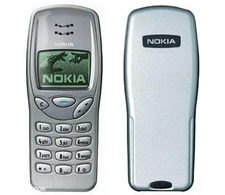| Nokia 3210 | |
| Screen | 1.5-inch backlit monochrome graphic LCD display 84×48 pixels, 64 PPI, 5 lines |
| Camera | None |
| Default ringtone | 40 monophonic ringtones, .nrt format |
| Memory card | no |
| Physical size | 123.8 × 50.5 × 16.7-22.5 mm |
| Weight | 151 g |
| Predecessor | Nokia 3110, Nokia 5110 |
| Successor | Nokia 3310 |
The Nokia 3210 was a highly popular cellular phone, first launched on March 18, 1999. A combination of cutting-edge features such as internal antennas and T9 (predictive text) ensured the 3210 huge commercial success (approximately 160 million units) especially across Western Europe and North America. This phone was succeed by the Nokia 3310.
The 3210 can also attribute much of its success to an advertising campaign which was aimed predominantly at young people, a first in the mobile phone industry. The inclusion of 3 games, changeable covers, internal antenna, customisable ringtones and competitive prices led to the handset's huge popularity with those aged 15–25.
Dimensions[]
The Nokia 3210 has a total weight of 153g. The handset measures 123.8 × 50.5 × 16.7 mm (min), 22.5 mm (max) and features customizable fascias which clip on.
Notable features[]
- 3 Games came preinstalled: Snake, Memory (pairs-memory game), and Rotation. The addition of such games encouraged high sales within a youth market which was enlarging at a very fast rate. Some versions of the 3210 included “hidden” games, React and Logic. They were activated by special software using data cable.
- The 3210 was one of the first mobile phones to feature an internal antenna. This distinguished the handset from others which featured a large, awkward and unsightly antenna. Reception, although poorer than that of its predecessor, the 3110, was still very good.
- 'Picture messages' sent via the SMS texting service, were implemented in the handset, allowing users to send preinstalled pictures to one another. These included a 'Happy Birthday' picture, amongst others.
- The handset was competitively priced and aimed particularly at teenagers and young professionals. This was at a time when few young people had access to a mobile phone, which was generally identified with older professionals and business people.
- The 3210 was the first to allow users to compose their own ringtone, a substantial benefit as previously customized ringtones could only be sent via SMS and at a charge.
- The 3210 was originally designed with a vibrate alert function. Nokia decided not to implement this feature on some handsets within certain jurisdictions. A few months after its UK release, some mobile phone repair shops offered customers a handset upgrade to the vibrate function for a small fee.
- The 'Grande valse' ringtone was renamed Nokia tune.
Handset specifications[]
- Standby time (h): 55–260
- Talk time (min): 180–270
- Charge time (h): 4
- Ringtone composer
- Dual-band: yes
- Vibrating alert (optional)
- Speed dialing
- 3 games
- Internal antenna
- Green backlight
- Interchangeable fascias
Reception[]
A combination of cutting-edge features such as internal antennas and T9 text entry ensured the 3210 huge commercial success. Much of the phone's success can also be attributed to an advertising campaign aimed predominantly at young people, a first in the mobile phone industry. The inclusion of 3 games, changeable “Xpress-on” covers (as on the previous Nokia 5110), an internal antenna, customisable ringtones and competitive prices led to the handset's huge popularity with those aged 15–25.
With 160 million units sold, the 3210 is one of the most popular and successful phones in history. It is considered one of the most significant handsets Nokia ever developed.
